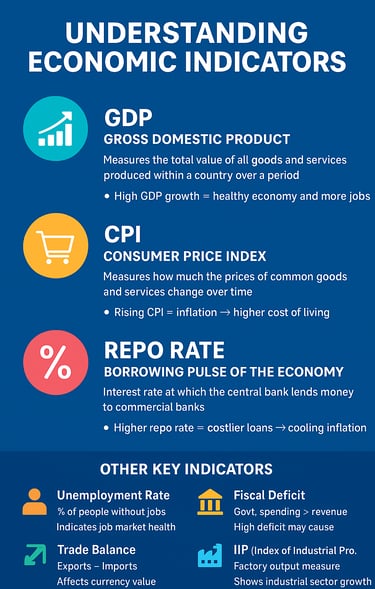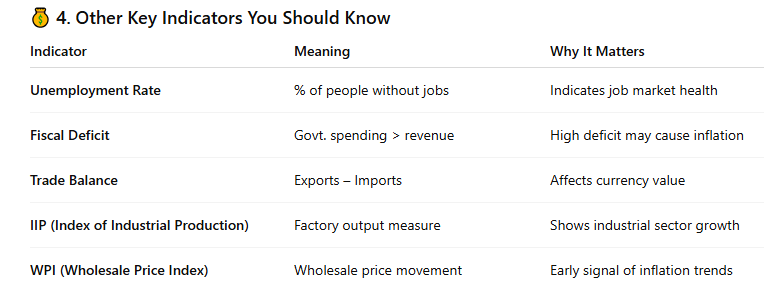Understanding Economic Indicators: GDP, CPI, Repo Rate Explained Simply
Learn what GDP, CPI, and Repo Rate really mean and how they affect your daily life, investments, and the economy. A beginner-friendly guide to understanding key economic indicators.
RAVINDRA PRAJAPATI (EDUCATIONAL BLOG)
10/5/20252 min read


Introduction: Why You Should Care About Economic Indicators
Ever wondered why markets crash, inflation rises, or your EMIs suddenly increase?
The secret lies in a few powerful signals economists call Economic Indicators.
They’re like a “health report” for the economy — showing how fast it’s growing, how expensive life is getting, and how stable money supply remains.
1. GDP – Gross Domestic Product (The Growth Meter)
What it means:
GDP measures the total value of all goods and services produced within a country over a period.
Why it matters:
High GDP growth = healthy economy and more jobs
Low or negative GDP = slowdown or recession
Investors track GDP to gauge which sectors will grow
Real-life example:
If India’s GDP growth jumps from 6% to 8%, businesses expand, stock markets rise, and consumer confidence improves.
2. CPI – Consumer Price Index (The Inflation Thermometer)
What it means:
CPI measures how much the prices of common goods and services (like food, rent, and fuel) change over time.
Why it matters:
Rising CPI = inflation → higher cost of living
Falling CPI = deflation → weaker demand
Central banks use CPI to decide monetary policies
Example:
If your groceries cost ₹100 last month and ₹110 now, CPI inflation is 10%.
3. Repo Rate – The Borrowing Pulse of the Economy
What it means:
The Repo Rate is the interest rate at which the central bank (like RBI in India) lends money to commercial banks.
Why it matters:
Higher repo rate = costlier loans (to control inflation)
Lower repo rate = cheaper loans (to boost growth)
Example:
If RBI raises repo rate, your home loan EMI may increase — slowing spending and cooling inflation.


5. How These Indicators Work Together
Think of GDP, CPI, and Repo Rate as parts of one system:
If GDP rises too fast, inflation (CPI) might increase.
RBI raises Repo Rate to slow inflation.
Higher rates slow borrowing → GDP growth stabilizes.
It’s a continuous balancing act between growth and stability.
6. Why Investors and Common People Should Track These
Helps you predict interest rate changes (for loans or EMIs)
Guides your investment decisions (equity, debt, gold)
Lets you understand market sentiment and policy moves
Builds financial awareness and confidence in decisions
Conclusion: Decode the Economy, Empower Your Wallet
Economic indicators may sound technical, but they shape every financial decision you make — from grocery bills to stock market returns.
Start tracking them, and you’ll see patterns that help you invest smarter and live more confidently.
Key tags:
#Finance101 #EconomicIndicators #GDP #CPI #RepoRate #FinancialLiteracy #SmartInvesting
RAVINDRA PRAJAPATI, Not a sebi registered
FOLLOW Us
ravindra.prajapati1122@gmail.com
+91 9795187745
© 2025. PiPiFinTech All rights reserved.
Contact Us
ABOUT Us
Our mission is to empower you to maximize every single penny and best solution for wealth generation and management for every mature age group.
Product TOPICS
Digital E-Wealth Platform
Mutual Funds
Education Planning
Insurance
FD and Bonds
Retirement Planning
Wealth Creation
(Disclaimers : Mutual Fund investments are subject to market risks, please read scheme related documents carefully.)
